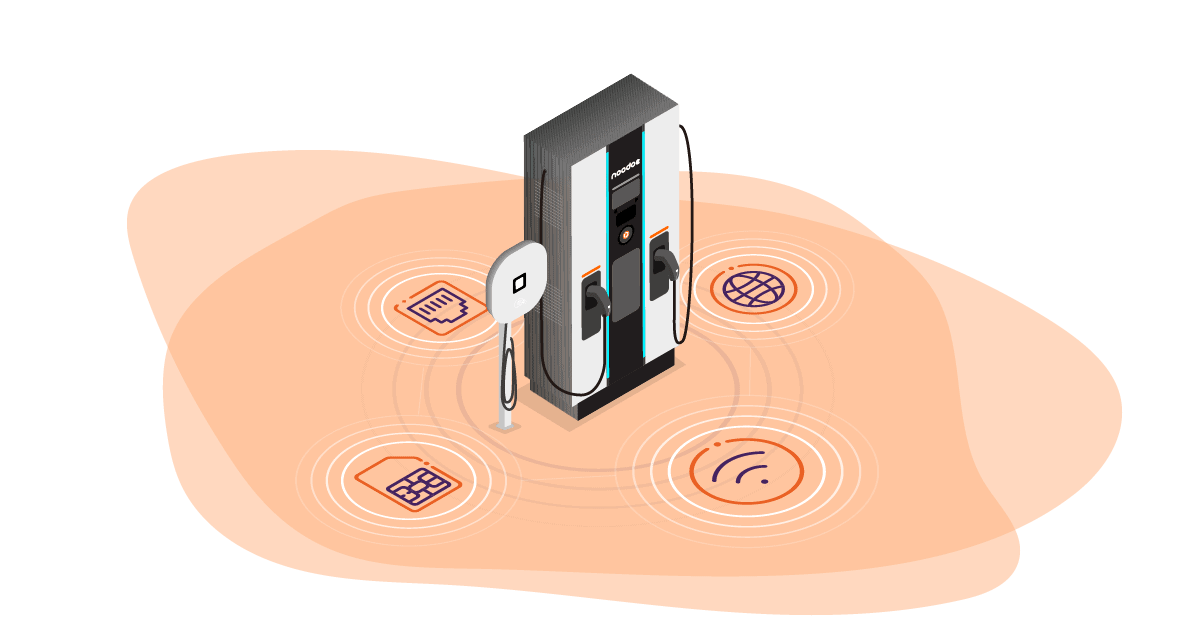Contact Info
2600 Technology Drive, Suite 100
Plano, Texas, 75074
United States
2600 Technology Drive, Suite 100
Plano, Texas, 75074
United States

Last Updated: March 1st, 2024 | EV Charging Management Platform
The world of EV charging has ultimately evolved to encompass chargers with full internet connection. These are third-generation chargers, and even when they provide the same core service of charging your EV, they are leagues ahead of the past chargers. Third-generation chargers have several unique characteristics that set them apart from the other generations. They fully connect to the network, meaning that can provide far more functionality but also that they require an internet connection.
There are several ways to provide an internet connection to your site. Together we can explore the connection methods thoroughly and help you create the optimal installation.
Cellular network service is an extremely reliable way of getting your chargers online with an internet connection, and what Noodoe recommends to most station owners. This method requires a 4G LTE capable charger and a data plan provided by Noodoe. With this method, Noodoe is fully responsible for managing this connection and data plan, so station owners have a hassle-free setup. This setup is ideal for any installation where reliable connectivity is paramount, and in medium or large parking lots where ethernet or Wi-Fi connections are not viable. Noodoe recommends to always check the cellular signal coverage when deciding on charger locations, as some areas like underground parking lots may not have sufficient coverage.
Wireless internet connection (Wi-Fi) is a convenient and cost-effective method in which all Noodoe supported EV chargers can connect to a local Wi-Fi router, or the Noodoe Gateway. It is imperative to remember that should you choose a Wi-Fi connection; the router should be a high-quality and commercial-grade router (which the Noodoe Gateway offers) to ensure stable operation. Household wireless routers can lead to downtime and charging disruption. While cost-effective, this setup has the disadvantage of a single point of failure. If the router goes down, all the chargers connected to it will also go offline. This setup is perfect for installations with several AC Level 2 chargers if you have reliable Wi-Fi or are installing the Noodoe Gateway.
An ethernet connection is the most physical way of provisioning your charging site with internet connectivity. This method requires ethernet-capable chargers and involves RJ45 cables AKA ethernet cables directly connected to each EV charger alongside wiring for power. It’s a reliable way to provide internet connectivity but can be expensive to install ethernet cables for each charger in locations with a large number of chargers. Similar to Wi-Fi setups, a connection to the local network is needed, and you do need a data center nearby for such an ethernet setup. Ethernet connections are best suited if you already have ethernet setup to charging location or in underground locations and concrete parking garages where Wi-Fi and cellular signals are poor.
Mixed-mode connection is the way to provide a connection through an on-site router that also connects to the internet through a sim card. This is a flexible solution that is perfect if you have more than one charger in a remote location, where ethernet cables or Wi-fi solutions are not viable due to the significant distance from the IT room or data center.
Third-generation chargers need to connect to a network as this is what enables smart operation, including benefits such as remote monitoring and troubleshooting. It is important to ALWAYS run your smart EV charger with an internet connection, regardless of the method, and refer to your user manual to understand which connection method is compatible with your charger.
| Cookie | Duration | Description |
|---|---|---|
| cookielawinfo-checkbox-analytics | 11 months | This cookie is set by GDPR Cookie Consent plugin. The cookie is used to store the user consent for the cookies in the category "Analytics". |
| cookielawinfo-checkbox-functional | 11 months | The cookie is set by GDPR cookie consent to record the user consent for the cookies in the category "Functional". |
| cookielawinfo-checkbox-necessary | 11 months | This cookie is set by GDPR Cookie Consent plugin. The cookies is used to store the user consent for the cookies in the category "Necessary". |
| cookielawinfo-checkbox-others | 11 months | This cookie is set by GDPR Cookie Consent plugin. The cookie is used to store the user consent for the cookies in the category "Other. |
| cookielawinfo-checkbox-performance | 11 months | This cookie is set by GDPR Cookie Consent plugin. The cookie is used to store the user consent for the cookies in the category "Performance". |
| viewed_cookie_policy | 11 months | The cookie is set by the GDPR Cookie Consent plugin and is used to store whether or not user has consented to the use of cookies. It does not store any personal data. |
